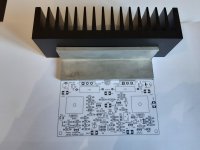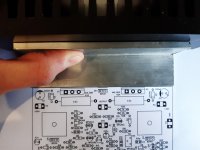Hi,
I've just received a heatsink for an amp I'm building (main thread over in Instruments and Amps, I split this here because it's a more specific problem) and the surface isn't flat. There is a slight concave along the width which means the aluminium angle won't mate properly. I've attached pictures of the problem.
The question is, how usual is this for heatsinks? Can I expect to return it and get a flat one or are the odds that that will also be curved? Should I just take it to a machine shop and have them skim it flat?
Thanks,
James
I've just received a heatsink for an amp I'm building (main thread over in Instruments and Amps, I split this here because it's a more specific problem) and the surface isn't flat. There is a slight concave along the width which means the aluminium angle won't mate properly. I've attached pictures of the problem.
The question is, how usual is this for heatsinks? Can I expect to return it and get a flat one or are the odds that that will also be curved? Should I just take it to a machine shop and have them skim it flat?
Thanks,
James
Attachments
Extruded heatsinks are often warped like that, but that is worse then most.
It is fairly common to need to take a face mill (or fly cutter) to the mating face of a heatsink to actually get good flatness, the raw extrusions are seldom good this way.
You can buy heatsinks that have had the face milled, but you pay a bit of a premium for them.
It is fairly common to need to take a face mill (or fly cutter) to the mating face of a heatsink to actually get good flatness, the raw extrusions are seldom good this way.
You can buy heatsinks that have had the face milled, but you pay a bit of a premium for them.
Do you think I should ask for an exchange then? It came from RS.
RS are usually a good reputable company.
I can only guess this one slipped their usually good quality standards.
Given it was described as a heatsink then it should be fully flat or its pretty useless.
Ring their customer support and ask for a replacement.
They are usually very helpful. I have had things missing and they have another one in post next day.
It won't get even using Sanding wet paper..
He will be there and rub it for TEN HOURS if it's 2 mm. and also it never will be even all the way. either exchang it for a good one , or get it milled. 2mm is a lot on the size of that surface, and with 600 or 400 wet it will be a long journey..
I was on a 5x7 cm copper piece for 6 hours with a FILE AND PAPER and I had only 0.8mm to correct.
Find some 1/2” glass and use wet/dry 600 or 400 grit and sand both mating surfaces
With wet sandpaper
No need to mill anything
Regards
David
He will be there and rub it for TEN HOURS if it's 2 mm. and also it never will be even all the way. either exchang it for a good one , or get it milled. 2mm is a lot on the size of that surface, and with 600 or 400 wet it will be a long journey..
I was on a 5x7 cm copper piece for 6 hours with a FILE AND PAPER and I had only 0.8mm to correct.
2 mm quite a lot, would you mind inform us what brand and model the heatsink is?
Don't even think of fixing it or force the L-profile flush with the heatsink as that would require much more than 3 bolts and could potentially warp the perpendicular part of the profile onto which you would attach your transistors to creating even more problem, you should definitely get that sorted out with RS.
Don't even think of fixing it or force the L-profile flush with the heatsink as that would require much more than 3 bolts and could potentially warp the perpendicular part of the profile onto which you would attach your transistors to creating even more problem, you should definitely get that sorted out with RS.
Last edited:
Hi,
Thanks for all the replies! This is the heatsink:
SK85-50-SA | Heatsink, Universal Rectangular Alu, 1.3K/W, 50 x 160 x 40mm | RS Components
I'm going to contact them tomorrow and ask to exchange it. If that one still isn't flat, I'll have it machined flat.
Thanks,
James
Thanks for all the replies! This is the heatsink:
SK85-50-SA | Heatsink, Universal Rectangular Alu, 1.3K/W, 50 x 160 x 40mm | RS Components
I'm going to contact them tomorrow and ask to exchange it. If that one still isn't flat, I'll have it machined flat.
Thanks,
James
I think its a cheapo chinese extrusion - I've got one like it, I think from eBay. Its flat enough for discrete transistors to mount, but will need facing on a metal mill for anything larger, its about 0.5mm out in the middle.
No, hand sanding isn't the way, milling is the best way to correct such a surface, a power belt sander might do at a pinch (but remember a sanding belt clogged with aluminium dust must never be used on rusty steel - thermite reaction).
No, hand sanding isn't the way, milling is the best way to correct such a surface, a power belt sander might do at a pinch (but remember a sanding belt clogged with aluminium dust must never be used on rusty steel - thermite reaction).
There is a Trick that it doesn't stuck. or clog
There is a trick to stop the file or the Sandpaper (I'm using 80 - 100Wood paper) to work on Copper or Aluminum.
Now, that it don't clog up use a piece of SOAP and rub the file or the Sandpaper before using it on the Copper or Aluminum. My Guarantee it will not clog up or much less. Do not use wet Soap..
If it still get stuck on the file, then use a Iron Brush to clean off, if you have rub the Soap beforehand onto the file, the leftovers which will be much less than without soap, will come off easily. Also its takes less force of your hand to rub it, because soap is the lubricant there,. and one will feel when it's time to renew the soap coat.
As for the Sand Paper just shake it good and you can use it several times.
As here has been said use a thick GLASS PLATE underneath on a flat surface, because the glass does not BEND that easy and so you can rub the working piece, of the paper and not visa versa, You will get a much better look of the piece you are working on..
Regards Chris
Ally is a bit of a **** for this, it tends to clog the abrasive.
There is a trick to stop the file or the Sandpaper (I'm using 80 - 100Wood paper) to work on Copper or Aluminum.
Now, that it don't clog up use a piece of SOAP and rub the file or the Sandpaper before using it on the Copper or Aluminum. My Guarantee it will not clog up or much less. Do not use wet Soap..
If it still get stuck on the file, then use a Iron Brush to clean off, if you have rub the Soap beforehand onto the file, the leftovers which will be much less than without soap, will come off easily. Also its takes less force of your hand to rub it, because soap is the lubricant there,. and one will feel when it's time to renew the soap coat.
As for the Sand Paper just shake it good and you can use it several times.
As here has been said use a thick GLASS PLATE underneath on a flat surface, because the glass does not BEND that easy and so you can rub the working piece, of the paper and not visa versa, You will get a much better look of the piece you are working on..
Regards Chris
Read PRR's Post - His answer is the one which works.
I think, PRR has the best answer from all these who have posted.
As you deal with only two Transistors there is no NEED to use that L-BAR. Mount the Transistors direct on that heatsink so you can save yourself a lot of Time, Troubles and Headache and last but not least, TIME. and possibly money.
If the HEAT SINK is larger than the PCB * from the Pics I see in your post PCB seems to be smaller than the heat sink*, then just mount it on that Heatsink and the Transistors also. Better heat Dissipation and smaller build.
But this is all up to you..
Get the best out of it you can.
Regards
Chris
Hi,
I've just received a heatsink for an amp I'm building (main thread over in Instruments and Amps, I split this here because it's a more specific problem) and the surface isn't flat. There is a slight concave along the width which means the aluminium angle won't mate properly. I've attached pictures of the problem.
The question is, how usual is this for heatsinks? Can I expect to return it and get a flat one or are the odds that that will also be curved? Should I just take it to a machine shop and have them skim it flat?
Thanks,
James
I think, PRR has the best answer from all these who have posted.
As you deal with only two Transistors there is no NEED to use that L-BAR. Mount the Transistors direct on that heatsink so you can save yourself a lot of Time, Troubles and Headache and last but not least, TIME. and possibly money.
If the HEAT SINK is larger than the PCB * from the Pics I see in your post PCB seems to be smaller than the heat sink*, then just mount it on that Heatsink and the Transistors also. Better heat Dissipation and smaller build.
But this is all up to you..
Get the best out of it you can.
Regards
Chris
- Status
- This old topic is closed. If you want to reopen this topic, contact a moderator using the "Report Post" button.
- Home
- Design & Build
- Construction Tips
- How flat should I expect a heatsink to be?

